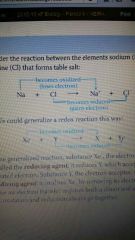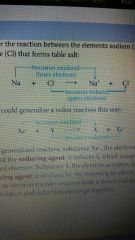![]()
![]()
![]()
Use LEFT and RIGHT arrow keys to navigate between flashcards;
Use UP and DOWN arrow keys to flip the card;
H to show hint;
A reads text to speech;
80 Cards in this Set
- Front
- Back
|
Why do organic compounds possess potential energy? |
As a result of the arrangement of electrons in the bonds between their atoms |
|
|
Fermentation |
CATABOLIC PROCESS -makes a limited amount of ATP from glucose... -without an ETC -produces an end product (like alcohol or lactic acid) |
|
|
What is the most efficient catabolic pathway? |
Aerobic respiration |
|
|
Cellular respiration |
Catabolic pathways of aerobic & anaerobic respiration -break down organic molecules & use an ETC for production of ATP |
|
|
Aerobic respiration equation |
organic compounds + O2 ------------> CO2 + water + energy |
|
|
Cellular respiration equation |
C6H12O6 + 6O2 --> 6CO2 + 6H2O + ATP/ENERGY |
|
|
Is cellular respiration exergonic or endergonic? |
EXERGONIC |
|
|
What is the free-energy change of cellular respiration? |
-686 kcal per mol of glucose decomposed (♢G = -686 kcal/mol) |
|
|
What does a negative ♢G mean? |
The products of the chemical process store less energy than the reactants The reaction can happen spontaneously (w/o an input of free energy) |
|
|
How do catabolic pathways (that decompose glucose & other organic fuels) produce energy? |
The relocation of electrons releases energy stored in organic molecules -this energy ultimately is used to synthesize ATP |
|
|
Redox reactions |
Chemical reaction involving the transfer of 1+ electrons from one reactant to another {short for reduction - oxidation reaction} |
|
|
Oxidation |
The loss of electrons or protons from a substance |
|
|
Reduction |
Addition of electrons or protons to a substance |
|
|
Reducing agent |

The electron/proton donors (Xe-) |
|
|
Oxidizing agent |

Electron acceptor (Y) |
|
|
What is oxidized in cellular respiration? |
C6H12O6 becomes oxidized (to 6CO2) |
|
|
What is reduced in cellular respiration? |
6O2 is reduced (to 6H2O) |
|
|
In respiration, the oxidation of glucose transfers _________ to a lower energy state. This liberates energy that becomes available for ATP synthesis. |
Electrons |
|
|
NAD+ |
Coenzyme & electron carrier |
|
|
Why is NAD+ well suited as an electron carrier? |
Because it can cycle easily b/n oxidized NAD+ and reduced NADH states |
|
|
As an electron {acceptor/donor}, NAD+ functions as an oxidizing agent during respiration. |
ACCEPTOR |
|
|
How does NAD+ trap electrons from glucose & other organic molecules? |
Dehydrogenases (enzymes) remove a pair of hydrogen atoms (2 electrons & 2 protons) from the substrate (glucose in this case)... -Thereby oxidizing it. -the enzyme delivers the 2 electrons & 1 proton to its coenzyme, NAD+ |
|
|
What causes NAD+ have its charge neutralized when reduced to NADH? |
NAD+ recieves 2 e- and 1 H+ |
|
|
What does each NADH molecule formed during respiration represent? |
Stored energy that can be tapped to make ATP when the electrons complete their "fall" down an energy gradient from NADH to O2 |
|
|
How do electrons that are extracted from glucose (and stored as potential energy in NADH) finally reach oxygen? |
Cellular respiration brings hydrogen & oxygen together to form water |
|
|
Electron transport chain (ETC) |
Sequence of electron carrier molecules (membrane proteins) -shuffle electrons down a series of redox reactions that release energy used to make ATP |
|
|
Where are ETCs located? |
Inner membrane of the mitochondria |
|
|
{In the ETC...} electrons removed from glucose are shuttled by ______ to the "top," higher-energy end of the chain. |
NADH |
|
|
{In the ETC...} at the "bottom," lower-energy end, ______ captures the electrons forming water |
O2 |
|
|
Electron transfer from NADH to O2 is an {exergonic/endergonic} reaction. |
Exergonic |
|
|
How is energy released efficiently when electrons are sent down the ETC? |
Electrons cascade down the ETC from one carrier molecule tonthe next... -losing a small amount of energy with each step -until they finally reach oxygen |
|
|
The electrons transfered from glucose to NAD+ fall down an _________ in the ETC to a more stable location in the electronegative oxygen atom. |
Energy gradient |
|
|
During cellular respiration, electrons travel this "downhill" route... |
Glucose ---> NADH ---> ETC ---> oxygen |
|
|
3 stages of cellular respiration |
1. Glycolysis 2. Krebs cycle 3. Oxidative phosphorylation |
|
|
Glycolysis |
A series of reactions that ultimately splits glucose into pyruvate |
|
|
Where does glycolysis occur? |
Cytosol |
|
|
Glycolysis begins by breaking glucose into ____________. |
2 molecules of pyruvate |
|
|
Once created, pyruvate enters the mitochondria and is oxidized to a compound called.... |
Acetyl coA |
|
|
Once pyruvate is oxidized to Acetyl coA, it enters the... |
KREBS CYCLE |
|
|
In the krebs cycle, the breakdown of ______ to ______ is completed. |
Glucose to carbon dioxide |
|
|
The energy released at each step of the ETC is stored in a form the mitochondria can use to make ______ from ______. |
ATP from ADP |
|
|
Oxidative phosphorylation |
Production of ATP using energy derived from the redox reactions of an ETC |
|
|
Substrate level phosphorylation |
ATP SYNTHESIS occurs when an enzyme transfers a phosphate group from a substrate molecule to ADP |
|
|
For each molecule of glucose degraded to CO2 and water by respiration, the cell makes up to about ___ molecules of ATP. |
32 |
|
|
What does the word "glycolysis" mean? |
"Sugar splitting" |
|
|
In glycolysis, glucose (6 carbon molecule) is split into ______, which are then oxidized. Remaining atoms are rearranged to form _______. |
2 (3-carbon) sugars; 2 molecules of pyruvate |
|
|
What is the net energy yield from glycolysis? |
2 ATP & 2 NADH |
|
|
Is any CO2 released during glycolysis? |
NO all the carbon originally present in glucose is accounted for in the 2 molecules of pyruvate |
|
|
Glycolysis occurs whether or not ____ is present. |
O2 |
|
|
If O2 is present, the chemical energy stored in pyruvate & NADH can be extracted by ______, ______, & ______. |
Pyruvate oxidation, Citric acid cycle, Oxidative phosphorylation |
|
|
How much chemical energy does glycolysis release? |
Less than 25% of chem. energy in glucose that can be harvested by cells (Most of the energy stays in the 2 pyruvates) |
|
|
If O2 is present, the pyruvate enters a mitochondria, where the ______ of glucose is completed. |
Oxidation |
|
|
Once inside the mitochondria, pyruvate undergoes a series of enzymatic reactions that do what? |
Remove CO2, oxidizes the remaining fragment- forming NADH from NAD+ |
|
|
The citric acid cycle generates __ ATP per turn by substrate level phosphorylation. |
1 |
|
|
Where does most of the chemical energy from the citric acid cycle go? |
Transferred to NAD+ & FAD. NADH & FADH2 shuttle their cargo of high energy electrons to the ETC |
|
|
For each turn of the krebs cycle, __ carbons enter an acetyl group. __ different carbons leave in CO2 molecules. |
2; 2 |
|
|
What forms citrate? |
The acetyl group of acetyl coA combines with oxaloacetate ( OAA ) ( step 1 ) |
|
|
What are the last 7 steps of the citric acid cycle doing? |
Decompose the citrate back to oxaloacetate |
|
|
For each acetyl group entering the citric acid cycle, ___ NAD+ are reduced to NADH (steps 3, 4, and 8) |
3 |
|
|
In step 6, electrons are transferred to FAD, which accepts __ electrons & __ protons to become FADH2. |
2; 2 |
|
|
In step 5, what produces a GTP molecule? |
Substrate level phosphorylation |
|
|
What does GTP do? |
Either used to make an ATP molecule or directly power work in the cell |
|
|
Is ATP generated during the citric acid cycle? |
Yes, ONCE. step 5 |
|
|
Most of the ATP produced by respiration is from... |
Oxidative phosphorylation... when NADH & FADH2 {produced by the citric acid cycle} relay the electrons extracted from food to the ETC. |
|
|
How many ATPs are produced from glycolysis & citric acid cycle? |
Each 2 atp per glucose molecule (By substrate level phosphorylation) |
|
|
Why is it good that the ETCs are in the cristae? |
Folds of the cristae make bigger surface area... thousands of ETC can go there |
|
|
During electron transport, electron carriers alternate between... And... States |
Reduced ; oxidized As they accept and donate electrons |
|
|
Is the upper part of the ATC less electronegative then the bottom part? |
Yes |
|
|
Electrons removed from glucose by NAD+ during glycolysis & the citric acid cycle are transferred from NADH to the first molecule of the electron transport chain in... |
Complex 1 |
|
|
Ubiquinone |
Small hydrophobic molecules that is mobile with in the membrane rather than residing in a particular complex |
|
|
Cytochromes |
A protein that is a component of electron transport chains |
|
|
What part of cytochrome accept and donate electrons? |
Their prosthetic group (heme group) has an iron atom that accept and donates electrons |
|
|
Fadh2 adds its electrons to the electron transport chain from within... At a lower energy level than NADH does |
COMPLEX II |
|
|
Does the electron transport chain provide less energy for ATP synthesis when the electron donor is fadh2 rather than NADH? |
Yes! |
|
|
Does the ETC make ATP directly? |
No! It eases the fall of electrons from food to oxygen, breaking a big free-energy drop into a series of smaller steps that release energy and manageable amounts |
|
|
ATP synthase |
Membrane protein complex Functions in chemiosmosis with adjacent electron transport chains using energy from a proton concentration gradient to make ATP |
|
|
Chemiosmosis |
Energy coupling mechanism that uses energy stored as a hydrogen ion gradient to drive cellular work such as the synthesis of ATP |
|
|
Proton motive force |
Potential energy stored as a proton electrochemical gradient generated by the pumping of hydrogen ions across a membrane during chemiosmosis |
|
|
Alcoholic fermentation |
Glycolysis followed by the reduction of pyruvate to ethyl alcohol. Regenerating NAD+ and releasing CO2 |
|
|
Lactic acid fermentation |
Glycolysis followed by the reduction of pyruvate to lactate. Regenerating NAD+ with no release of CO2 |

